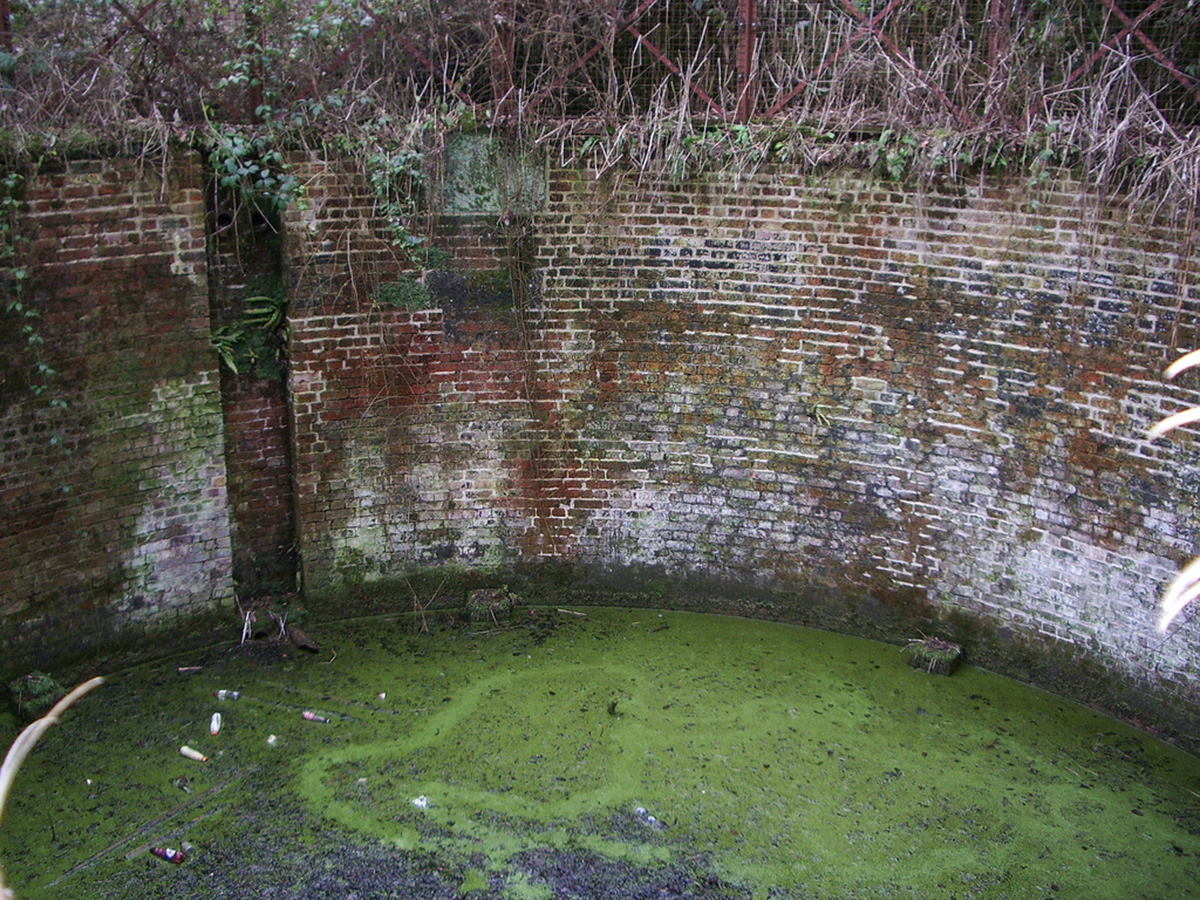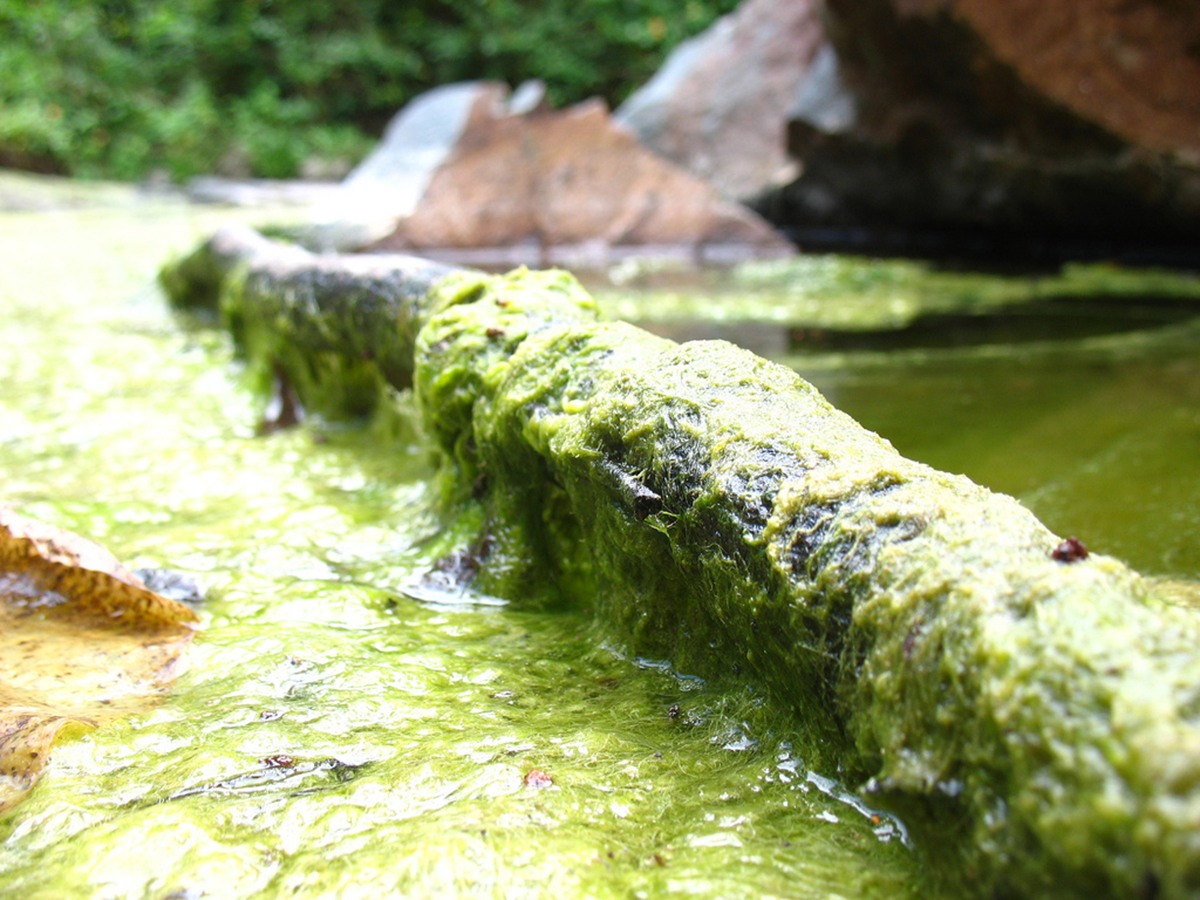British health officials have sounded an alarm about rates of motor neuron diseases such as amyotropic lateral sclerosis (ALS or Lou Gehrig's disease, known in the UK as motor neuron disease), Alzheimer's disease, and dementia up to 25 times normal near certain lakes and reservoirs.
The common factor in over a million potential cases of degenerative brain disease in the UK alone is a chemical called beta-methylamino-L-alanine, or BMAA, an amino acid produced by certain kinds of algae.

How Can Pond Slime Cause Brain Disease?
The algae that make BMAA don't attack the brain directly, the way an infection might. Instead, they produce a toxin that can get into the human food supply. The sequence of steps runs like this:
- Algae grows in still, fresh water in ponds and lakes during the summer months. Runoff that includes animal manure or nitrogen fertilizer helps it grow.
- The algae produces a the potent BMAA toxin. Both the algae and the toxin are consumed by other microorganisms, and by fish, that are in turn caught and eaten by humans.
- In the human brain, BMAA gets incorporated into proteins in the same places that the brain would ordinarily use the amino acid serine. BMAA gives the protein an unusual shape, and the protein forms tangles that are characteristic of ALS, Alzheimer's disease, progressive supranuclear palsy, Parkinson's disease, and Lewy body disease.
Although the pond slimes that produce BMAA are producing a major health crisis in Britain, scientists didn't begin to understand the disease there. The mystery of BMAA was actually unraveled after an epidemic of brain disease swept Guam.
An Epidemic of Brain Disease in the West Pacific
Guam has been an American territory since the end of the nineteenth century, but American doctors stationed on the island didn't notice a serious health problem until the 1950's. (Guam was occupied by Japan in World War II, and reconstruction tasks had taken priority until the 1950's.) Large numbers of the native Chamorro people developed an unusual kind of dementia that had features of both Alzheimer's and ALS.
The condition affected natives and Filipino immigrants to the island who adopted native culture, the Filipino immigrants not getting sick until they had been on the island for 10 years or more, but not people who stayed in American administrative quarters. It wasn't something in the air or the water or spread by mosquitoes. It was also something that was a lot worse in some places than in others. At the height of the outbreak in the 1950's, nearly every family in the fishing village of Umatac on the southern coast of Guam had at least one member who had the disease.
READ No Strong Evidence Proofs that a Diet or a Lifestyle have an Effect on Alzheimer’s Disease
When the local medical examiner did autopsies, an unusual malformation known as neurofibrillary plaques, a kind of tangled protein, was noticed. There wasn't a clear pattern, however, in the development of the disease. Some people got it earlier in life, and some got it later. Native Chamorro people, the original inhabitants of the island, got the disease, while Japanese ex-pats living on the island and Americans at the military base did not. There had to be something affecting the native Guamanians that wasn't part of the everyday life of more recent arrivals.
A Batty Solution to a Medical Mystery
The culprit in the local diet turned out to be fruit bats. The native cuisine of Guam includes one ingredient most non-Pacific cultures shun, roasted whole "flying foxes," which are giant fruit-eating bats, without even the hair or guts removed. It's a local treat that even most American service members tend to shun. Fruit bats feed on local fruits, including the fruits of the cycad palm, which is another plant that makes the BMAA toxin. Finally, in 2015, experiments with animals confirmed that consuming the cycad fruit caused the disease.
Brain Disease Caused By BMAA Toxin Not Limited To Island Nations
The alarming reality of BMAA toxicity is not just that exposure to the toxin has caused whole generations to get sick on Guam and that the toxin may play a role in up to 1,000,000 cases of ALS, Alzheimer's, Parkinson's disease, supranuclear palsy, and other degenerative brain diseases in the UK. Even more alarming is the fact that a number of common foods can be contaminated with the toxin.
- On Guam, the toxin in cycad seeds was 10,000 times more concentrated in bat meat than in the cycad seeds the bats ate, but it was also concentrated in the flesh of other animals that fed on the seeds, including pigs and deer. The Guamanians also used the seeds to make flour for tortillas, compounding the problem.

- A large variety of marine bacteria produce BMAA, which is concentrated in plankton, and concentrated some more in tiny crustaceans that eat the plankton, and concentrated still more in animals that eat the baby shrimp and the animals that eat them. Predator fish such as sharks accumulate toxic amounts of BMAA, especially in their fins, making shark fin soup a deadly dish to eat on a regular basis.
- "Bottom feeding" animals that live in waters filled with sediment are apt to accumulate BMAA. The poison has been detected in mussels and oysters in France and Spain, and it can also accumulate in fresh-water catfish.
- Simply living around a lake where BMAA-producing bacteria grow may be associated with the disease. This seems to be the case in Britain, where 12 clusters of ALS have been identified around lakes and reservoirs, and in New Hampshire in the United States, where there is a concentration of ALS patients around Mascoma Lake, a rural area just 10 miles from Dartmouth Medical School, and even in Canada, where at least two cases have been identified in Toronto.
READ Is it Alzheimer or is it Low Blood Level of Vitamin B12?
How can you avoid BMAA and avoid the brain diseases it causes?
The obvious answer is to avoid fruit-bat stew. However, no matter how you consume BMAA, whether it is in contaminated sea food, certain toxic plants almost never consumed outside the western Pacific, or in drinking water, it accumulates in the brain. The way to deal with the problem is to make sure you get enough of another amino acid that "crowds out" BMAA so it does not build up in brain tissue.
That amino acid is L-serine. Holistically oriented physicians have been recommending L-serine supplements for their Alzheimer's patients for years. If you regularly eat sea food, or if you live near a lake that accumulates slime in the summer, or if your city gets its water from a lake that is smelly in the summer or when the seasons change (and changes in water temperature bring sediments to the surface), then it's probably a good idea to add L-serine to your nutritional supplement routine. Foods that are especially good sources of serine include egg whites, soy and "soy nuts," sesame seeds, sunflower seeds, Parmesan cheese, and, ironically, Atlantic cod. Since BMAA acts as an exitotoxin, it also should also help to avoid amplifying its effects by avoiding aspartame (Nutrasweet).
- Cox PA, Davis DA, Mash DC, Metcalf JS, Banack SA. Dietary exposure to an environmental toxin triggers neurofibrillary tangles and amyloid deposits in the brain. Proc Biol Sci. 2016 Jan 27. 283(1823). pii: 20152397. doi: 10.1098/rspb.2015.2397. PMID: 26791617.
- Photo courtesy of Smabs Sputzer: www.flickr.com/photos/10413717@N08/4355024802/
- Photo courtesy of orinrobertjohn: www.flickr.com/photos/orinrobertjohn/155468631


Your thoughts on this